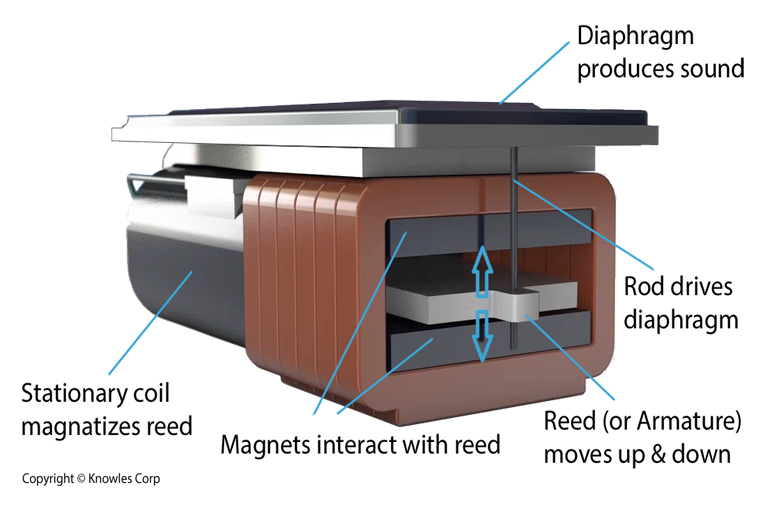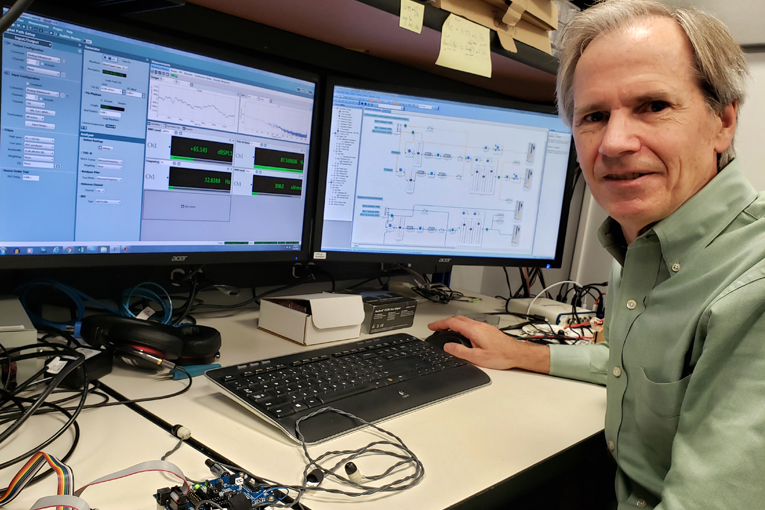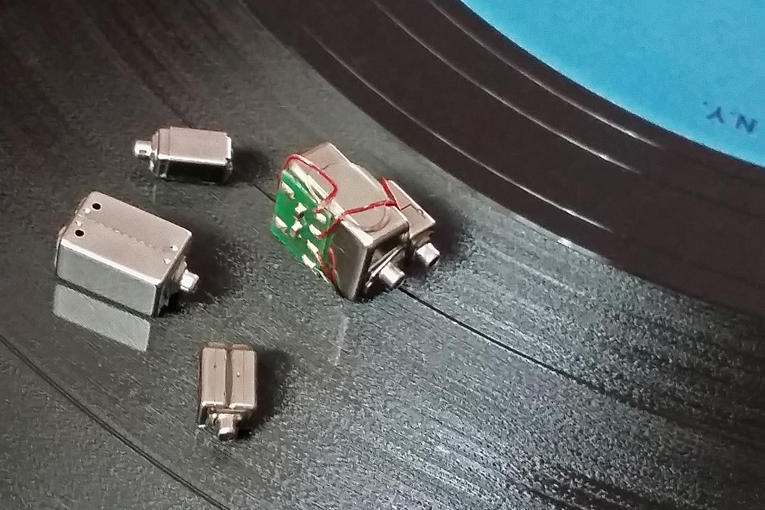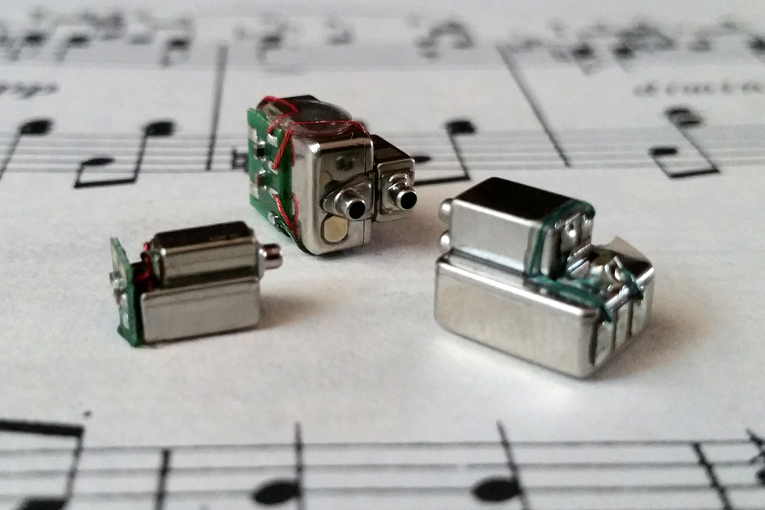With a few rare outliers excepted, there are two different types of earphone drivers: dynamic drivers and balanced armatures. Although great earphones have been made with either type of driver, and often contain both types, the two drivers are very different in form and performance. Most headphone enthusiasts understand the concept of dynamic drivers, which are basically just miniaturized versions of conventional speakers, but many do not understand how balanced armatures work, or what their advantages and disadvantages are.
Hugh Knowles invented balanced armatures in 1955 to serve the hearing-aid market, and the company he founded, Knowles Electronics, remains the leading supplier. To dig deeper into this subject, I interviewed Knowles Electronics’ director of market development, Andrew Bellavia, and senior principal engineer, Tom Miller.

First, a quick primer. A dynamic driver uses a coil of wire (or voice coil) wound around a cylindrical former attached to a diaphragm, and a magnetic gap that the coil moves through. Run voltage through the coil and the diaphragm moves back and forth, just like a standard tweeter or woofer. A balanced-armature driver works on similar principles, but has a reed that runs through a stationary voice coil, and is attached with a tiny rod to a diaphragm. Run voltage through the coil, the coil magnetizes the reed, and the reed vibrates, which in turn vibrates the diaphragm.
Brent Butterworth: What is the advantage of a balanced armature over a dynamic driver?
Andrew Bellavia: The main difference is that the coil in a balanced armature is not moving. In a dynamic driver, the coil is part of the moving mass, and in the smaller sizes of those drivers, this imposes a limitation on the number of turns of wire. In a balanced armature, since the coil is not moving, you can have more turns, which means a stronger magnetic field, and you have more latitude in the driver impedance.
 Andrew Bellavia
Andrew Bellavia
Tom Miller: Balanced armatures also are much smaller than dynamic drivers, so they can tuck into nooks and crannies. That’s great for true wireless earphones, where there’s so little room for a speaker, and it can even give you room for a couple of drivers -- a balanced-armature woofer and tweeter packaged together where you could fit only a single dynamic driver. This is especially an advantage in wired earphones, where you don’t have electronic EQ available. With multiple drivers and a crossover, you have more tuning options. And we have thousands of different models available, with different impedances earphone manufacturers can choose from, so often the crossover needs only a single capacitor.
The balanced-armature tweeters are so small you can put them all the way down by the eartip, and the closer to the ear you get, the better the high-frequency performance. If you have to attach the driver to a skinny pipe to get the sound to the ear, as you do with dynamic drivers, the air has inertia, and it doesn’t move back and forth as readily at high frequencies.
 Tom Miller
Tom Miller
AB: Balanced armatures are fast and responsive, so you get every little aspect of the music. We’re always focused on delivering good, accurate music reproduction.
BB: What are the technical challenges of using balanced armatures?
AB: Dynamic drivers tend to have larger diaphragms with more excursion, so they can move more air. So for people who want that elevated bass, a dynamic driver can really give that to you. For that reason, dynamic drivers are easier to use in active noise-canceling systems, because the canceling takes place mostly in the bass and you need that strong bass to counteract incoming noise. Although sometimes ANC earphones will combine a dynamic driver with a balanced armature in a hybrid design.
TM: With the biggest dynamic drivers, you don’t have to rely on a tight seal in the ear canal so much to get good bass, and the positioning of the earphone in the ear canal becomes less critical to the sound quality. That also allows them to use vent holes for the consumers who find full occlusion of the ear canal uncomfortable, but without sacrificing too much bass. But then the long acoustical path from the dynamic driver to the ear hurts high-frequency performance.
And when you get into the larger dynamic drivers, you might have 50 turns of wire, and because the circle around which the wire is wound is bigger, the coil gets heavier. Then, because the wire is longer, you have to use a thicker wire to keep the impedance the same. This makes the mass go up with the square of the diameter. You can end up with a driver that has weak high-frequency response. But if you pair that with a balanced armature for the high frequencies, it can be great.
Also, balanced armatures are pretty much indestructible thermally because you can use bigger wire without increasing the moving mass, and the motor provides a nice heatsink for the voice coil. Customers ask what the power handling of our drivers is, and we actually don’t know! But this is mainly a concern for designers, because no matter what driver is used, the manufacturer of the earphone is going to build the earphone so there’s no danger of overheating for the end user.
BB: Are balanced armatures evolving to better suit new applications like true wireless earphones?
AB: Yes, we’re moving on several fronts. First, we’re getting more output for a given size. That’s especially important for the hearing-aid market because they can make their products smaller and more comfortable. That also applies to true wireless earphones, one area where our hearing-aid research spills over into consumer earphones.
We’re also working on waterproof designs. We already have some models that can do IPX7 [immersible in 1m of water for 30 minutes]. We’re also working on improved drivers for IPX5 [able to withstand jets of water] applications. Some headphone companies do their IPX5 rating with the water jet sprayed against the body, but some companies want their earphones to be able to be washed under running water, where water could get sprayed down the nozzle of the earphone. I’m not aware of any dynamic drivers that can survive that, nor balanced armatures at the moment, but we’re working on it.
BB: I’ve measured lots of balanced-armature earphones, and I almost always see a big upward swing in the impedance above 1 or 2kHz. Is that a problem when designing earphones with balanced armatures?
TM: It’s an advantage. It’s a coil wound around a piece of metal, so it’s an inductor and the impedance rises with frequency. But the acoustical response doesn’t fall much with frequency, so the rising impedance makes it more efficient and better for battery life. This also makes it especially good for use with the new energy-efficient class-D amplifier chips that Qualcomm has released. Those chips don’t have filters to block the ultrasonic output of the class-D amplifier. Because our device is very inductive, it blocks the ultrasonic output and you don’t need an external filter.

BB: I know Knowles was founded to serve the hearing-aid business. When did you transition to consumer earphones?
AB: There’s an interesting story to that. In the 1990s, Karl Cartwright of Westone collaborated with Jerry Harvey, who was working with Van Halen at the time. Building on some earlier work, they developed in-ear monitors for professional musicians to protect their hearing. Because the balanced armature is a sealed metal can, it can give better isolation than a dynamic driver, which has to have a space behind it. Out of those efforts grew Westone’s music division, Ultimate Ears, and JH Audio.
Etymotic Research, which was founded by a former Knowles employee, launched some consumer earphones with balanced armatures, but they weren’t major-market products. Balanced armatures hit it big in consumer products about 12 years ago, when Apple introduced consumer earphones with dual balanced armatures. You can still go on YouTube and see Steve Jobs hyping them [scroll in about 1 minute]. They sold that model for about ten years until the Lightning connector came along and the headphone jack went away.
BB: Will balanced armatures ever be able to compete in the bass with a 10mm dynamic driver?
AB: It depends on what you’re after. Our latest dual-woofer balanced armature will push 120dB. But its bass characteristic is different from dynamics. To me, the dynamic sounds softer, warmer, fuller, but a little less precise. People who want that basshead response will go for dynamic every time. But if you want flat, precise response all the way down to the sub-bass, balanced armatures are better for that. They have a more gradual rise in the bass compared with dynamic drivers.
In their work on the Harman curve, Sean Olive and his team found the worst-sounding earphones are ones where the midbass is too high. So in the AKG N5005 [regarded as the earphone that comes closest to the Harman curve], they used dual balanced-armature woofers and tweeters, and a dynamic subwoofer to get that steep rise in bass output, from about 200Hz and down, without having it bleed into the midbass.
TM: You would never do that in a Bluetooth headphone, though, because you could just have one woofer and use EQ to shape the bass response.
BB: Does it cause frequency-response problems, putting a tweeter in front of a dynamic woofer? In speakers, that’s usually a bad idea.
TM: In earphones, almost all the gaps and tubes are smaller than the wavelengths of sound you’re dealing with, so you just have to look at the total amount of acoustical impedance. The tweeter is small enough that it doesn’t shadow the dynamic driver much. But you can get a cancellation notch around 6 or 8kHz if the tweeter sound goes backwards towards the chamber in front of the woofer. This is fixed by adjusting the tweeter port location and the woofer chamber shape. We often see that with a customer’s first prototype, and on the second try they’ll smooth it out. As with any crossover, one also has to make sure the woofer and tweeter are not out of phase with each other in the crossover region, which would mean one driver’s pushing while the other’s pulling.
We have an automated system where, when we come up with a new model, we can generate an electrical circuit model that mimics the acoustical response of the system. The earphone manufacturer can just put in the length and diameter of the tube, and they can predict how the driver will behave in that situation. Some dynamic-driver manufacturers offer this, too, so the earphone makers can model hybrid designs.

AB: We often work together with the customer on implementation. That becomes more common with hybrids because integrating them to get the desired sound signature becomes tricky, so we will work on driver positioning and impedance with them. We did that for the Soundcore Liberty 2 Pro earphones.
Nobody buys a loudspeaker with one driver in it -- even the new base model Amazon Echo announced a few days ago has woofers and tweeters in it. So multiple drivers is a great way to go, and you’re probably going to use at least one balanced armature for that. Even one balanced armature in combo with a dynamic driver can make a great-sounding earphone.
BB: Is there anything else that headphone enthusiasts should know about balanced armatures, now and coming up in the near future?
AB: For true wireless earphones, the size and power efficiency of balanced armatures is a big advantage. A company called Shanling recently launched two true wireless earphones, one with a 6mm dynamic and one with a single Knowles balanced armature. They published battery run time specs on both and got six hours on the dynamic and seven on the balanced armature. That battery life difference will continue to increase. As DSP current demand keeps going down and down, the percentage of current consumed by the driver is higher; when DSP current goes down by half, a balanced armature will then have a two- or three-hour advantage.
TM: The hearing-aid market uses almost exclusively balanced armatures because they need that battery to last all week, and their batteries are smaller than the ones in true wireless earphones. As we move into lower power consumption in the electronics, with Bluetooth Low Energy, this is going to give balanced armatures an even bigger advantage going into the future.
. . . Brent Butterworth
All photos © Knowles Electronics







